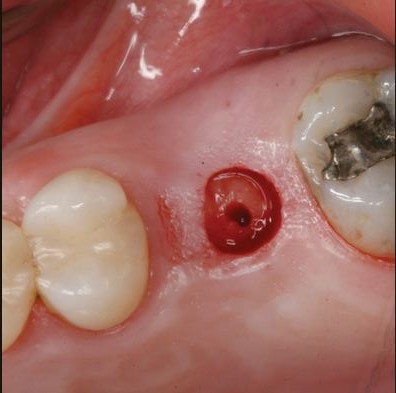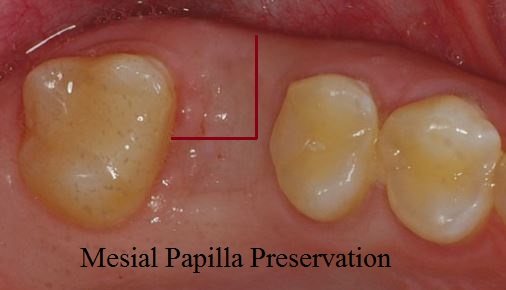Implantology is major part of Dentisty now and every Dentist is interested in including Implantology in their Dental Clinic. There are many courses and Diplomas which are giving you required education and also the required practical exposure to do implants on your own. So let us here look at one of the basics which are required to excel in Dental Implant placement. There are many factors which should be considered while placement of implants like the Tissues surrounding Dental Implants
Types of Flap Design Options for Dental Implants:
The various Flap designs which are required in various teeth and which have to be adjusted according to the current situation and here are “Seven types of Flap desings” which can be used in your daily Implants practice.
Punch Approach:
This type of Flap design for implant placement is used only in cases where the tissue quality if good with a minimum of 2-3mm of attached and keratinized gingiva is available. This design can be done with the help of a common BP Blade or you can also use “Punch” tool or Punch Drill for this to get it precisely. To attain precise placement of the Punch for implant placement it is a must to use a Surgical Guide with the help of Planning Software. This is the simplest type of flap design where raising of any Soft tissue is not required.

1/2 Punch Approach:
This is another typed of Flap design for implant placement which is a modification of the Punch Approach. This flap design is used in cases where the buccal tissue is not sufficient or deficient. to make this 1/2 Punch Approach flap design you have to first Create a mid-crestal incision and reflect a full thickness flap. Then the use of a Punch approach is seen where only the required or minimal amount of lingual/palatal tissue is removed which is required for implant placement. This Flap design is used mostly in cases with I-stage procedure with possible simultaneous immediate grafting is possible.

Mid Crestal Flap:
This is a Flap design is done in cases where sufficient buccal and Lingual or Palatal tissue is present. In this technique the incision is made in the middle of the crest which is intra-sulcular to the adjacent teeth. Here after the incision is given full thickness buccal and lingual/palatal flaps are raised or reflected to expose the site of implant placement to the surgeon. this is one of the most common types of flap designs after the Punch approach. This design can be used in I-stage or 2-stage procedure where simultaneous grafting is available or can be used for grafting alone.

Palatal/Lingual Crestal Flap:
This is a type of flap design where there is insufficient or less Buccal tissue available to raise a full thickness flap. So the Incision which is similar to the Mid Crestal one is given towards the Lingual or Palatal side of the Arch and the Flap is raised to perform the next Step. Here simultaneous Contour grafting is required and this flap design can be used in 1-Stage or 2-stage Implant procedure.

Mesial Papilla Preservation type Flap:
This type of Flap design is used when there is need to preserve the mesial papilla to maintain the aesthetics in certain cases. Here the mesial papilla is preserved by using a vertical releasing incision which is connected to a crestal incision and an intra-sulcular incision on the distal tooth is given which will preserve the mesial papilla. This type of flap design is used in 2-stage placement and uncovering to help in getting maximum aesthetics by not loosing the mesial papilla while the placement procedure.

Distal Papilla Preservation type Flap:
This type of Flap design is used when there is need to preserve the Distal Papilla which is needed to allow preparatory bone grafting procedure. Here the incision is similar to the Mesial Papilla Preservation flap but should be given on the opposite side. Here the distal papilla is given by using a vertical releasing incision connected to a crestal incision and a intra-sulcular incision on the mesial tooth. As mentioned above this is useful in preparatory bone grafting and not for aesthetics.

Double Papilla Preservation:
This type of flap design is used to preserve both Mesial and Distal Papilla, both these are preserved even in the Punch Type flap as well but this is given in 2-stage placement approach where uncovering of good amount of tissue is mobilized towards the buccal aspect. Here 2 vertical releasing incisions are given and connected with a Lingual or Palatal Crestal incision which will let you raise the flap towards the buccal aspect.

Source: Paradent LLC
Dental implants have helped me in a massive way. I used to feel bad about smiling in pictures but I never stop smiling! This is a really good blog and I hope people take the time to read it and maybe get inspired to get their own implants!
Good and precise information about dental bridges. I wanted to get the procedure done but was unaware about how exactly it is done and if i should really go for it. Now that i am clear about it, i can look forward for my implant. I also got good information when I came across this video of where a patient from Australia shares his experience at Dentzz as i am willing to travel anywhere in India to get the best treatment done. At last it is a big decision and that the effect shall last long.
Great information about dental implants.
Thanks Varun for sharing very helpful and interesting content on flap designs. Really very helpful for medical students and dentists.
Good post. I learn something totally new and challenging on blogs I stumble upon on a daily basis. It will always be interesting to read articles from other authors and practice something from their websites…
Thanks, so informative and helpful in the implant daily practice.
This article is very informative. Thanks for sharing this article its really helpful for many of us.
very nice and precise ,but in cases of mandibular implant,you did not show where to but the incision ,buccal or lingual in addition to the crestal line as in the upper teeth